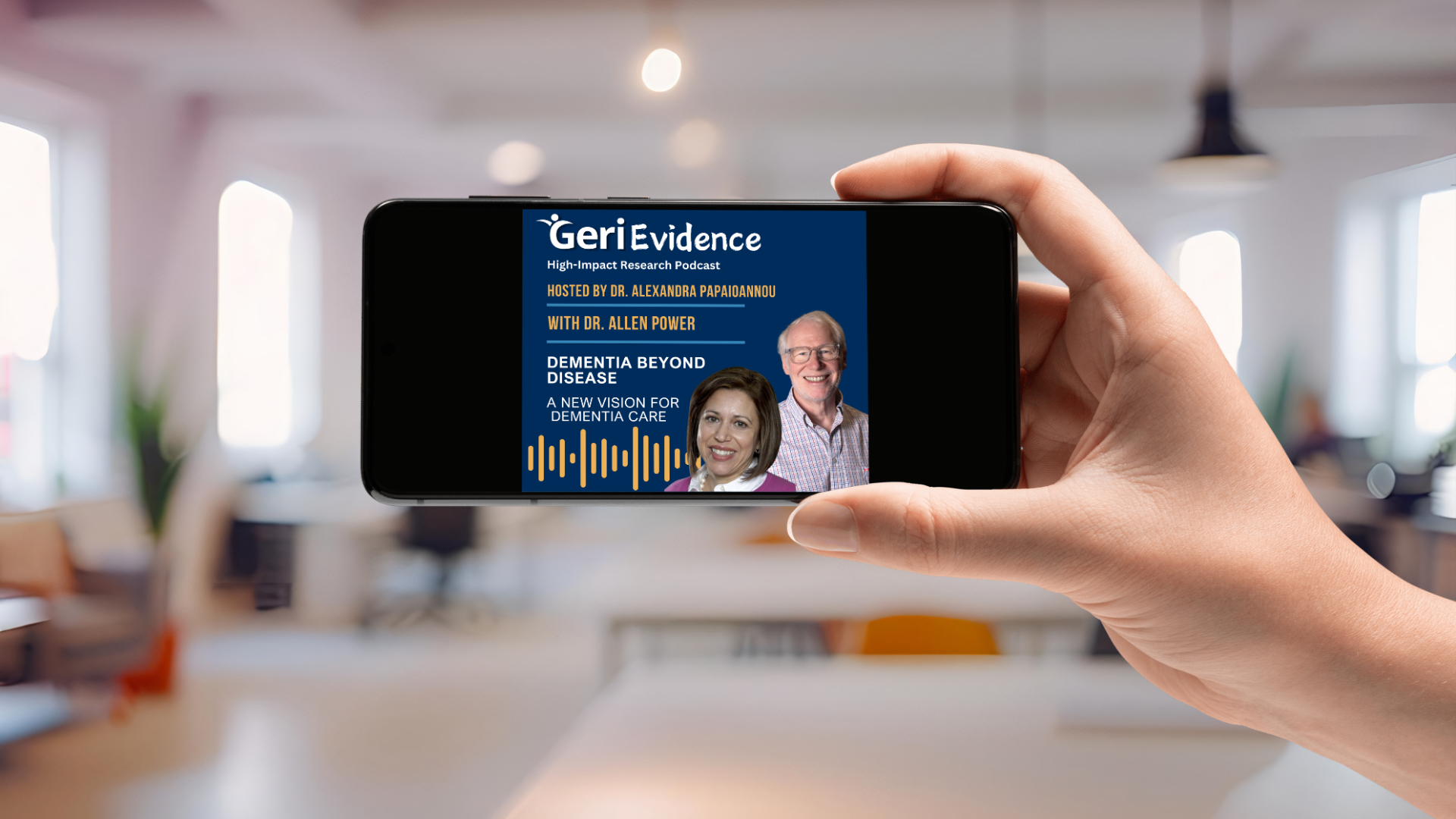“My grandfather was always immaculately dressed; without exception, he wore a freshly pressed shirt tucked into pleated trousers, his hair combed back like Fred Astaire, with a matching twinkle in his eye. A Second World War veteran and career firefighter, he was sharp-minded but soft-spoken, always quick with a teasing remark about my fashionably distressed jeans and vegetarian diet; and with a perpetual appreciation for the small things in life — like my grandma’s scalloped potatoes.”
As one of our co-authors, Rebekah Sibbald, describes, “He went into the hospital with a broken hip, and never came out.”
She explains, “When he came out of hip surgery, he was no longer himself. It was heartbreaking: he could not leave his bed, but he kept trying to go home. He was so disoriented and confused that they eventually had to forcefully restrain him, and he lost trust in his loved ones. The healthcare staff kept raising their voices — assuming that his misunderstanding must be due to a hearing issue, though that was not the case at all. He rapidly deteriorated.”
Though poorly understood, delirium is experienced by a significant proportion of older adults; the prevalence varies, depending on where and how it’s measured. For older adults who undergo hip fracture surgery, the rate is as high as 11 per cent. More broadly, it affects as many as 50 per cent of hospitalized adults over 65, with estimates reaching 87 per cent for older adults in intensive care, and 88 per cent for those in palliative care settings. In Canada, delirium is the third most common cause of unintended harm experienced by patients as a result of their medical treatment.
For some, delirium manifests as quiet withdrawal and mild disorientation; others may not be able to recognize their care team or family members, while becoming distrustful and anxious. Despite its prevalence, the cause of delirium is very poorly understood, and estimates of misdiagnosis are as high as 65 per cent.
With that in mind, there are three things that the public, including all healthcare workers and caregivers, should know about delirium:
1. Delirium is a sudden change in attention and thinking ability caused by an underlying medical condition.
Delirium is a brain disorder involving confusion, a reduced ability to focus and pay attention, and less awareness of the environment. It usually develops over a short period of time and fluctuates during the course of a day. By definition, these disturbances are caused by an underlying medical condition or a treatment, including drug-related side effects. Older adults are at a higher risk, especially those with dementia and COVID-19; however, the causes are often complex and overlapping. Events commonly triggering delirium include surgery, stroke, infection, dehydration and pain.
Despite its prevalence, especially in older adults, delirium should never be considered a ‘normal’ part of aging, illness or care after an operation.
2. Delirium profoundly impacts the health of older adults — and their families.
With its sudden onset, it is assumed that delirium occurs only with acute period of illness or an isolated visit to an emergency department visit. Though this is often true, delirium can last for 12 months after the initial diagnosis, with reduced attention, disorientation and memory problems persisting the most often. Its impact can be profound: studies show that delirium is an independent contributor to health outcomes in older persons, including decline in physical and thinking abilities (in some cases dementia), future admission to a hospital or care home, and — as with our co-author’s grandfather — mortality.
The full impact of delirium extends beyond the patient. Family members report a lack of awareness about delirium, and experience feelings of loss, distress, shock, fear and frustration in caring for loved ones with delirium. This is complicated by the fact that, like physicians, nurses often do not recognize delirium, and report difficulty in distinguishing it from conditions such as dementia and depression.
As our co-author describes, her grandfather’s experience with delirium had lasting effects on her family. As she explains, “For some of my family members, this experience with delirium has worsened an existing fear of hospitals, and especially of any procedure involving anesthesia — even those as routine as a colonoscopy.”
3. Most importantly, delirium can be treated and prevented.
If delirium is suspected, the patient should receive prompt professional support, with attempts to determine the underlying causes, alongside immediate treatment. This should involve supportive healthcare, management of symptoms, anticipating and preventing complications, restoring daily activities and focused treatment of the underlying causes.
Prevention is more straightforward; in fact, 30 to 40 per cent of hospital acquired delirium can be prevented with non-drug tactics. None of these are particularly novel or innovative — we’ve known about them for a quarter-
century, and they are well supported by the scientific literature. These preventive measures are also extremely accessible, and can be led by families, caregivers and health care workers alike. We’ve highlighted them in the table below:
Non-Drug Actions to Prevent Delirium
Develop an orientation ‘board’ to familiarize patient with names of family and friends or the care team members and daily schedule; provide orienting communication at least once a day.
Trigger: Reduced thinking ability
Encourage activities to stimulate the brain, such as talking with family or care team members three times a day, and customized options according to leisure interests and physical impairments.
Trigger: Unable to move ‘naturally’
Promote early movement, such as walking or range-of-motion exercises, three times a day, depending on patient health status; avoid use of immobilizing equipment and physical restraints.
Trigger: Problems with hearing and vision
Provide visual and hearing aids; use special communication techniques, with daily reinforcement; ensure removal of communication impediments such as language barriers, or even earwax.
Trigger: Dehydration
Recognize dehydration and ensure satisfactory liquid intake; provide encouragement during meals; and multi-step instructions depending on patient health status.
Trigger: Unable to sleep
Use non-medical sleep supports, such as warm drinks, relaxing music or sounds and massage; reduce noise throughout living environment; reschedule medications and procedures to allow uninterrupted sleep.
Trigger: Using multiple drugs and inappropriate medications
Minimize or avoid drugs affecting mind and behaviour; monitor drugs daily, and discuss strategies with an interdisciplinary care team.
In the case of our co- author, we can’t know if a better understanding of delirium for both his family and treatment team would have changed the course of her grandfather’s end-of-life. He may still have never left the hospital; in the distress arising from his delirium, our co-author’s family never learned a cause of death.
She adds this final thought: “Either way, it would have made his time in the hospital less challenging for everyone involved — most of all him. That time might have been less fearful, more dignified more peaceful.”
Rebekah Sibbald is a medical student at the Michael G. DeGroote School of Medicine, McMaster University.
Dr. Samuel Thrall is a geriatrician at Niagara Health and an assistant professor in the department of medicine at McMaster University.
Professor Chambers is research director of the Niagara Regional Campus, Michael G. DeGroote School of Medicine, McMaster University, and maintains appointments at the Bruyere Research Institute; the Faculty of Health, York University; and ICES, an independent, non-profit corporation for health services research and population-wide health outcomes research in Ontario.
Original Source – https://healthydebate.ca/2023/05/topic/delirium-prevention/


